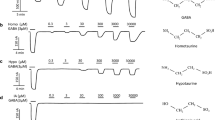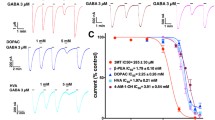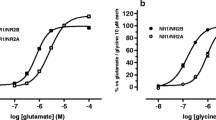Abstract
Anandamide is an endogenous cannabinoid receptor agonist with similar pharmacological effects as D9-tetrahydrocannabinol, the major psychoactive compound in marijuana. Because anandamide does inhibit long-term potentiation, and cannabinoid abuse is known to affect learning and memory, the effects of anandamide on recombinant AMPA glutamate receptor (GluR) subunit currents were studied in Xenopus oocytes. All subunit currents were not affected by SR-1 41716A (a selective CB1 cannabinoid receptor antagonist), but were blocked by the selective AMPA antagonist CNQX and were sensitive to anandamide. Anandamide directly inhibited kainate (KA) activated homomeric GluR1; GluR3 and heteromeric GluR1/3; GluR2/3 receptor currents with IC50 values of 161±19, 143±12, 148±10 and 241±107 µM, respectively.
The sensitivity of all the subunits to anandamide was not significantly different. Anandamide inhibition was voltage-independent, specific, and could not be duplicated by arachidonic acid or WIN 55,212-2 mesylate. Furthermore, anandamide effects were potentiated by forskolin (an adenylyl cyclase stimulator) and 8-bromo-cAMP (a cAMP analog), whereas MDL-HCl (an adenylyl cyclase inhibitor) caused a reversal of anandamide inhibition of GluR receptor current. Anandamide inhibition appears to be mediated by cAMP synthesis, and may underlie the involvement of this brain cannabinoid agonist in the modulation of fast synaptic transmission in the CNS.
Similar content being viewed by others
Author information
Authors and Affiliations
Additional information
Electronic Publication
Rights and permissions
About this article
Cite this article
Akinshola, B., Taylor, R., Ogunseitan, A. et al. Anandamide inhibition of recombinant AMPA receptor subunits in Xenopus oocytes is increased by forskolin and 8-bromo-cyclic AMP. Naunyn-Schmiedeberg's Arch Pharmacol 360, 242–248 (1999). https://doi.org/10.1007/s002109900078
Received:
Accepted:
Published:
Issue Date:
DOI: https://doi.org/10.1007/s002109900078




